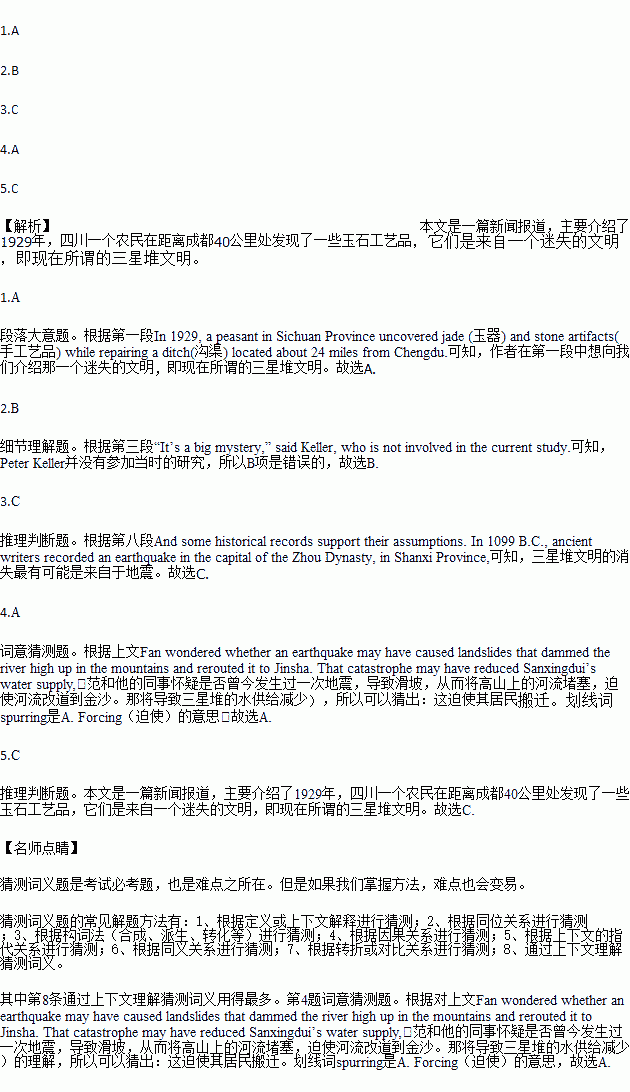题目内容
In 1929, a peasant in Sichuan Province uncovered jade (玉器) and stone artifacts(手工艺品) while repairing a ditch(沟渠) located about 24 miles from Chengdu. But their significance wasn’t understood until 1986, when archaeologists unearthed two pits(大坑) of Bronze Age treasures. The discovery suggests an impressive technicality(手工技艺), said Peter Keller, a geologist and president of the Bowers Museum in California, which is currently hosting an exhibit of some of these treasures.
The treasures came from a lost civilization, now known as the Sanxingdui, a city on the banks of the Minjiang River.
“It’s a big mystery,” said Keller, who is not involved in the current study.
“Archaeologists now believe that the culture disappeared sometime between 3,000 and 2,800 years ago,” Niannian fan, a river science researcher at Tsinghua University in Chengdu, China, said.
“The current explanations for why it disappeared are war and flood, but both are not very convincing,” Fan told Live Science.
But about 14 years ago, archaeologists found the remains of another ancient city called Jinsha near Chengdu. The Jinsha site, though it contained none of the bronzes of Sanxingdui, did have a gold crown covered with fish, arrows and birds similar to golden objects found at Sanxingdui. That has led some scholars to believe that the people from Sanxingdui may have relocated to Jinsha.
Fan wondered whether an earthquake may have caused landslides that dammed the river high up in the mountains and rerouted it to Jinsha. That catastrophe may have reduced Sanxingdui’s water supply, spurring its people to move.
And some historical records support their assumptions. In 1099 B.C., ancient writers recorded an earthquake in the capital of the Zhou Dynasty, in Shanxi Province, Fan said. Though that spot is roughly 250 miles from the historic site of Sanxingdui, the latter culture didn’t have writing at the time. So it’s possible the earthquake epicenter(震中) was actually close to Sanxingdui-but it just wasn’t recorded there.
Around the same time, geological sediment(沉积物) suggest massive flooding occurred, and the later-han Dynasty document The Chronicles of the Kings of Shu records ancient floods pouring from a mountain in a spot that suggests the flow being rerouted, Fan said.
Together, the findings hint that major earthquake triggered a landslide that dammed the river, rerouting its flow and reducing water flow to Sanxingdui, Fan said.
1.In the first paragraph, the author wants to _____.
A. introduce the topic of a lost civilization
B. tel us how beautiful the jade and stone artifacts look
C. remind us to pay attention to the earthquake
D. inform us we can easily find treasures in a ditch
2.According to the passage, the following statements are true EXCEPT that ______.
A. Bowers Museum is exhibiting some of Bronze Age treasures
B. Peter Keller is the lead researcher on the study of Sanxingdui
C. some scholars think that the people from Sanxingdui may have moved to Jinsha
D. some findings support the idea that an earthquake caused a landslide, which dammed the river, rerouting its flow and reducing water flow to Sanxingdui
3.Which of the following is the most probable explanation of mystery of the disappearance of Sanxingdui’s civilization?
A. War. B. Flood.
C. Earthquake. D. Hurricane.
4.Which of the following is closest in meaning to the underlined word “spurring” in the seventh paragraph?
A. Forcing. B. Allowing.
C. Supporting. D. Favoring.
5.What type of writing is this passage?
A. Science fiction. B. An official document.
C. A newspaper report. D. A research report.

